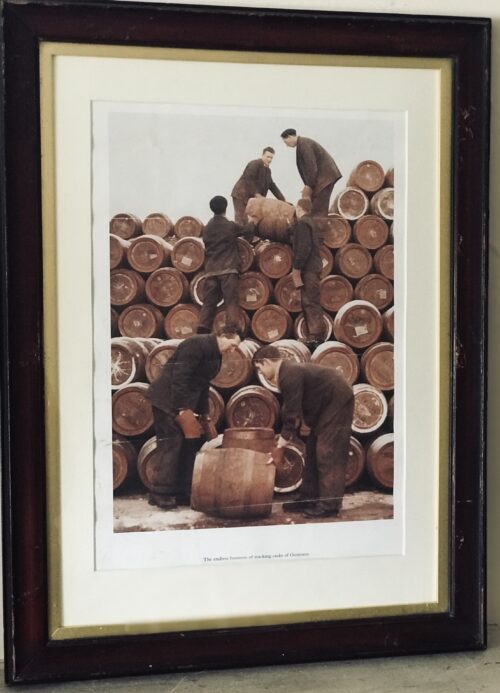Superbly framed print of the Guinness Coopers Tools.Formerly displayed in the Dublin Chamber of Commerce.
Origins : Dublin Dimensions :60cm x 45cm Glazed
Guinness Coopers
Background Information
The craft of 'coopering' involves the manufacture of wooden casks. Various hand tools were used with great skill to fashion wooden 'staves' (long thin curved individual sections) which were then fastened together with metal hoops forming different sizes of cask, or wooden vessels such as pails and churns. Coopering has been practised for many centuries and is still practised in some parts of the world today. Those who make the casks are known as 'Coopers'. This page provides a wonderful chance for you to get to know a little bit more about where your favourite drink comes from. Next time you are at the pub with your mates drinking a Guinness you will know that extra information about how it is made.
There are three main categories of coopering known as white, dry and wet. White coopering involves the manufacture of pails, butter churns, tubs and other household utensils for daily use. Dry coopering involves the manufacture of casks for holding dry goods such as flour, tobacco or vegetables. Wet coopering involves the manufacture of casks for holding liquids, it was considered the most highly skilled, and it was wet coopering that was practised in the cooperage at Guinness.
Sizes of Cask
Wooden casks are frequently referred to as 'barrels' but the word 'barrel' actually refers to a specific size of cask. Sizes of cask include:
Firkin, with 8 gallon capacity
Kilderkin, with 16 gallon capacity
Barrel, with 32 gallon capacity
Hogshead, with 52 gallon capacity
Butt, with 104 gallon capacity
The Skill of the Cooper
Different sizes of cask require different sized staves and hoops. The staves and hoops remain in place purely because they are very precisely fashioned. The cooper might have used upwards of thirty different types of tool in making a cask. Coopering demanded great skill and precision. This skill was only learned through a rigorous apprenticeship, which might take from five to seven years. In addition the trade was a 'closed' one so that it was passed down from generation to generation within the same family.
The cooper did not rely on written measurement or patterns to make a cask of specific size. Everything was gauged by the eye and perfection was required since each cask must be airtight, strong enough to withhold the force of fermenting beer, and sufficiently durable to withstand years of rough handling.
Guinness was the dominant employer in Dublin. In the 1920s about 300 coopers (half the city's total) worked here. These coopers were highly paid tradesmen within the brewery.
In addition to making the casks the coopers were called upon to conduct repairs and clean any returned casks which might have been damaged in transit or acquired a foul smell by being left lying empty for too long. Some coopers were specially appointed as 'smellers' to weed out these foul smelling casks for treatment in the cask repair shop. The majority of coopers were engaged in the making and repairing of casks.
A cooper could be paid for each cask he made and repaired instead of a weekly wage, this was known as 'piecework'. Those coopers who could combine speed with quality profited handsomely. Coopers on piecework could earn four times as much as a cooper on wages and work less hours to do so.
Coopering within Guinness
Guinness had its own team of coopers working on site producing all the wooden casks which carried GUINNESS® to its customers in Ireland and around the world. These coopers were highly paid tradesmen within the brewery.
Wooden casks were used by Guinness for almost two hundred years. In 1946 aluminium kegs were introduced and began to replace the wooden cask. There was a period of transition during which wooden casks were used alongside the new metal casks for some years before they were discontinued. The aluminium keg was replaced by stainless steel in the late 1980s. Three hundred coopers were employed at Guinness but by 1961 this number had declined to only 70. The last wooden cask was filled at St. James's Gate brewery in March 1963.
The Process
The process of making a cask might involve the use of over thirty different types of tool, mostly used for cutting and paring the wood. Many stages were involved and a cooper might have several casks on the go at once rather than following one through, at a time, from beginning to end. A brief account is given below of the process outlining the main stages and noting some of the tools used. The account is followed by twelve photographs which illustrate parts of the process.
Stave Preparation
Casks for GUINNESS® were traditionally made using Prime American White Oak. The wood required 'seasoning' or drying. The timbers for making the 'staves' were stacked in large piles under cover outside allowing for the free passage of air between them, and were left for a minimum of two years. Then the coopers would carefully select timbers for making the staves and the cask making process could begin.
A cooper first prepared the individual wooden staves which joined together to form the cask. This stage of preparation was known as 'dressing'. It involved the use of a variety of sharp paring tools, including an 'axe' and several differently shaped curved blades. Using these tools a cooper would first cut the stave roughly to size then carefully hone it down to its exact size, and slightly curved shape, using a number of different knives. Then finally the stave was passed over a 'jointer' (a free-standing plane) angling its edges so it would join smoothly with the other staves when brought together to form a watertight seal. This process would be repeated with each of the staves until there were enough to form a cask.
Forming the cask shape
The staves were then brought together in the next stage known as 'raising up'. Here staves were gathered and placed standing upright inside a metal hoop forming the cask shape. The cooper then fixed the staves roughly together by hammering a hoop down over their top end.
The staves then had to be bent into the characteristic cask shape with tapering ends and a central outward bulge. To bend the staves a special machine known as a 'steam bell' was used. Shaped like a large bell this machine would be lowered down over the staves and subjected them to high steam pressure which softened the wood. When the cask was removed from the steam bell coopers would bring together the splayed ends using a rope and then quickly hammer down more temporary hoops over the staves, forcing them to bend together into the curved cask shape.
The cask was then placed over a pile of wood shavings which were set alight to char the inside of the cask drying it out, setting its shape and sealing the wood.
Preparing for the 'Heads'
The cask ends were then prepared to receive their two lids, known as 'heads'. Using more paring and cutting tools the two top edges of the cask at either end were cut away into a bevel with the very top edge flattened to ensure the casks would stand steady. Then a groove was cut below the sloping edge with a 'croze' where the heads would fit. Now the cask was ready for its heads.
Before the heads were made and slotted into the grooves at either end of the cask the inside and outside of the cask had to be pared down until very smooth. Finally a hole was bored into the side where the wooden bung or cork would fit. This hole was fitted with a brass 'bush', a brass ring which lined and reinforced the hole. It was through this 'bung hole' that the beer could be tapped out.
Fitting the 'Heads', the 'Hoops' and Finishing Off
Now finally the heads could be made and fitted. To make the circular head, comprised of several individual planks slotted together, the cooper used a compass to measure the inside of the top of the cask ends. Then he would cut out the right sized circle, using a 'bow saw', from the roughly shaped circular head he had made. This was the only time in the whole of the cask making process that a cooper would use such a measuring tool, all other measurements being made with the coopers' skilled and experienced eye. Once cut to shape all the head surfaces were made smooth using specially shaped paring tools, and the edges were bevelled to fit into the thin groove inside the cask ends. Now the two heads were slotted into the grooves at either end of the casks, a piece of 'flag' (rush) being placed on the inside of the groove first to ensure a watertight seal.
With both heads in place the cooper might make final adjustments by smoothing down the surfaces again and would make a fresh set of hoops which were hammered down into place over the staves. Finally the heads of the casks were branded with an individual identification number and thename of 'Guinness'. Now the cask was finished and ready to be filled with GUINNESS® and transported around Ireland and the world.
Arthur Guinness started brewing ales in 1759 at the St James Gate Brewery,Dublin.On 31st December 1759 he signed a 9,000 year lease at £45 per annum for the unused brewery.Ten years later, on 19 May 1769, Guinness first exported his ale: he shipped six-and-a-half barrels to Great Britain before he started selling the dark beer
porter in 1778.
The first Guinness beers to use the term were Single Stout and Double Stout in the 1840s.
Throughout the bulk of its history, Guinness produced only three variations of a single beer type: porter or single stout, double or extra and foreign stout for export.
“Stout” originally referred to a beer’s strength, but eventually shifted meaning toward body and colour.
Porter was also referred to as “plain”, as mentioned in the famous refrain of
Flann O’Brien‘s poem “The Workman’s Friend”: “A pint of plain is your only man.”
Already one of the top-three British and Irish brewers, Guinness’s sales soared from 350,000
barrels in 1868 to 779,000 barrels in 1876.
In October 1886 Guinness became a public company, and was averaging sales of 1,138,000 barrels a year. This was despite the brewery’s refusal to either advertise or offer its beer at a discount.
Even though Guinness owned no
public houses, the company was valued at £6 million and shares were twenty times oversubscribed, with share prices rising to a 60 per cent premium on the first day of trading.
The breweries pioneered several quality control efforts. The brewery hired the statistician
William Sealy Gosset in 1899, who achieved lasting fame under the pseudonym “Student” for techniques developed for Guinness, particularly
Student’s t-distribution and the even more commonly known
Student’s t-test.
By 1900 the brewery was operating unparalleled welfare schemes for its 5,000 employees.
By 1907 the welfare schemes were costing the brewery £40,000 a year, which was one-fifth of the total wages bill.
The improvements were suggested and supervised by Sir
John Lumsden. By 1914, Guinness was producing 2,652,000 barrels of beer a year, which was more than double that of its nearest competitor
Bass, and was supplying more than 10 per cent of the total UK beer market.
In the 1930s, Guinness became the seventh largest company in the world.
Before 1939, if a Guinness brewer wished to marry a
Catholic, his resignation was requested. According to Thomas Molloy, writing in the
Irish Independent, “It had no qualms about selling drink to Catholics but it did everything it could to avoid employing them until the 1960s.”
Guinness thought they brewed their last porter in 1973.
In the 1970s, following declining sales, the decision was taken to make Guinness Extra Stout more “drinkable”. The gravity was subsequently reduced, and the brand was relaunched in 1981.
Pale malt was used for the first time, and isomerized hop extract began to be used.
In 2014, two new porters were introduced: West Indies Porter and Dublin Porter.
Guinness acquired the
Distillers Company in 1986.
This led to a
scandal and criminal trialconcerning the artificial inflation of the Guinness share price during the takeover bid engineered by the chairman, Ernest Saunders. A subsequent £5.2 million success fee paid to an American lawyer and Guinness director, Tom Ward, was the subject of the case
Guinness plc v Saunders, in which the House of Lords declared that the payment had been invalid.
In the 1980s, as the IRA’s bombing campaign spread to London and the rest of Britain, Guinness considered scrapping the Harp as its logo.
The company merged with
Grand Metropolitan in 1997 to form
Diageo.
Due to controversy over the merger, the company was maintained as a separate entity within Diageo and has retained the rights to the product and all associated trademarks of Guinness.

The Guinness Brewery Park Royal during demolition, at its peak the largest and most productive brewery in the world.
The Guinness brewery in
Park Royal, London closed in 2005. The production of all Guinness sold in the UK and Ireland was moved to
St. James’s Gate Brewery, Dublin.
Guinness has also been referred to as “that black stuff”.
Guinness had a fleet of ships, barges and yachts.
The Irish
Sunday Independent newspaper reported on 17 June 2007 that Diageo intended to close the historic St James’s Gate plant in Dublin and move to a greenfield site on the outskirts of the city.
This news caused some controversy when it was announced.The following day, the
Irish Daily Mail ran a follow-up story with a double page spread complete with images and a history of the plant since 1759. Initially, Diageo said that talk of a move was pure speculation but in the face of mounting speculation in the wake of the
Sunday Independent article, the company confirmed that it is undertaking a “significant review of its operations”. This review was largely due to the efforts of the company’s ongoing drive to reduce the environmental impact of brewing at the St James’s Gate plant.
On 23 November 2007, an article appeared in the
Evening Herald, a Dublin newspaper, stating that the Dublin City Council, in the best interests of the city of Dublin, had put forward a motion to prevent planning permission ever being granted for development of the site, thus making it very difficult for Diageo to sell off the site for residential development.
On 9 May 2008, Diageo announced that the St James’s Gate brewery will remain open and undergo renovations, but that breweries in Kilkenny and Dundalk will be closed by 2013 when a new larger brewery is opened near Dublin. The result will be a loss of roughly 250 jobs across the entire Diageo/Guinness workforce in Ireland.
Two days later, the
Sunday Independent again reported that Diageo chiefs had met with
Tánaiste Mary Coughlan, the deputy leader of the Government of Ireland, about moving operations to Ireland from the UK to benefit from its lower corporation tax rates. Several UK firms have made the move in order to pay Ireland’s 12.5 per cent rate rather than the UK’s 28 per cent rate.
Diageo released a statement to the London stock exchange denying the report.
Despite the merger that created Diageo plc in 1997, Guinness has retained its right to the Guinness brand and associated trademarks and thus continues to trade under the traditional Guinness name despite trading under the corporation name Diageo for a brief period in 1997.
In November 2015 it was announced that Guinness are planning to make their beer suitable for consumption by vegetarians and vegans by the end of 2016 through the introduction of a new filtration process at their existing
Guinness Brewery that avoids the need to use
isinglass from fish bladders to filter out yeast particles.
This went into effect in 2017, per the company’s FAQ webpage where they state: “Our new filtration process has removed the use of isinglass as a means of filtration and vegans can now enjoy a pint of Guinness. All Guinness Draught in keg format is brewed without using isinglass. Full distribution of bottle and can formats will be in place by the end of 2017, so until then, our advice to vegans is to consume the product from the keg format only for now.
Guinness
stout is made from water,
barley, roast malt extract,
hops, and
brewer’s yeast. A portion of the barley is roasted to give Guinness its dark colour and characteristic taste. It is
pasteurisedand
filtered.
Until the late 1950s Guinness was still
racked into wooden casks. In the late 1950s and early 1960s, Guinness ceased brewing cask-conditioned beers and developed a keg brewing system with aluminium kegs replacing the wooden casks; these were nicknamed “iron lungs”.
Until 2016 the production of Guinness, as with many beers, involved the use of
isinglass made from fish. Isinglass was used as a fining agent for settling out suspended matter in the vat. The isinglass was retained in the floor of the vat but it was possible that minute quantities might be carried over into the beer.
Diageo announced in February 2018 that the use of isinglass in draught Guinness was to be discontinued and an alternative clarification agent would be used instead. This has made draught Guinness acceptable to vegans and vegetarians.
Arguably its biggest change to date, in 1959 Guinness began using nitrogen, which changed the fundamental texture and flavour of the Guinness of the past as nitrogen bubbles are much smaller than CO
2, giving a “creamier” and “smoother” consistency over a sharper and traditional CO
2 taste. This step was taken after
Michael Ash – a mathematician turned brewer – discovered the mechanism to make this possible.
Nitrogen is less soluble than carbon dioxide, which allows the beer to be put under high pressure without making it fizzy. High pressure of the dissolved gas is required to enable very small bubbles to be formed by forcing the draught beer through fine holes in a plate in the tap, which causes the characteristic “surge” (the
widget in cans and bottles achieves the same effect). This “widget” is a small plastic ball containing the nitrogen. The perceived smoothness of draught Guinness is due to its low level of carbon dioxide and the creaminess of the head caused by the very fine bubbles that arise from the use of nitrogen and the dispensing method described above. “Foreign Extra Stout” contains more carbon dioxide, causing a more acidic taste.
Contemporary Guinness Draught and Extra Stout are weaker than they were in the 19th century, when they had an
original gravity of over 1.070. Foreign Extra Stout and Special Export Stout, with abv of 7.5% and 9% respectively, are perhaps closest to the original in character.
Although Guinness may appear to be black, it is officially a very dark shade of
ruby.
The most recent change in alcohol content from the Import Stout to the Extra Stout was due to a change in distribution through North American market. Consumer complaints have influenced recent distribution and bottle changes.
Studies claim that Guinness can be
beneficial to the heart. Researchers found that “‘
antioxidantcompounds’ in the Guinness, similar to those found in certain fruits and vegetables, are responsible for the health benefits because they slow down the deposit of harmful
cholesterol on the artery walls.”
Guinness ran an advertising campaign in the 1920s which stemmed from market research – when people told the company that they felt good after their pint, the slogan, created by
Dorothy L. Sayers–”Guinness is Good for You”. Advertising for alcoholic drinks that implies improved physical performance or enhanced personal qualities is now prohibited in Ireland.
Diageo, the company that now manufactures Guinness, says: “We never make any medical claims for our drinks.”




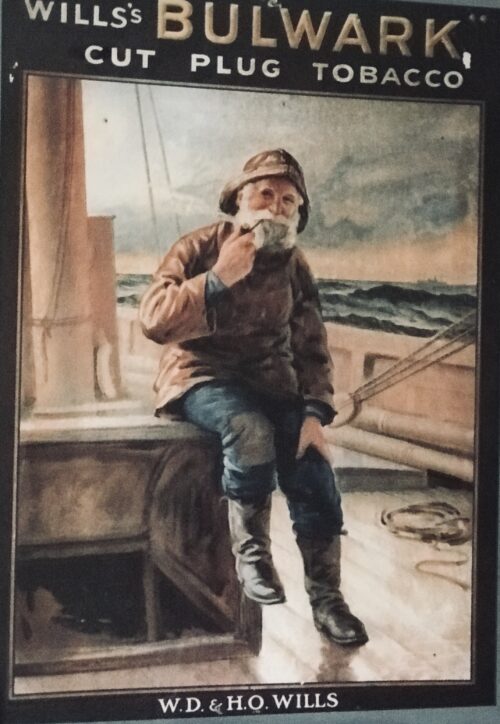
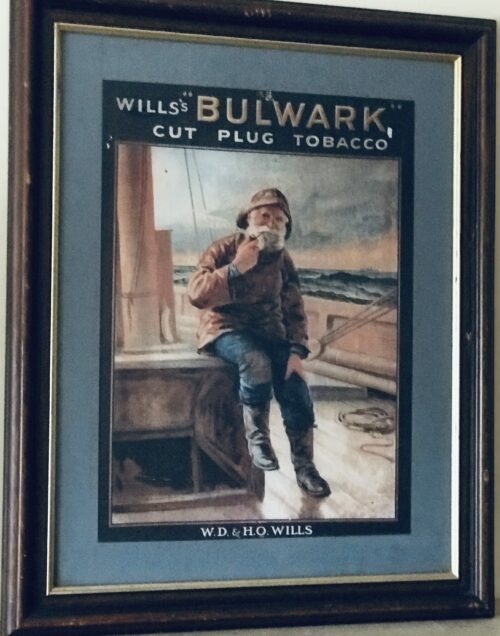









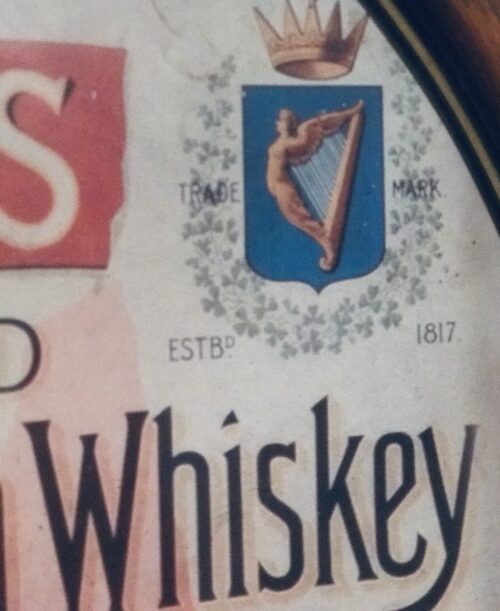
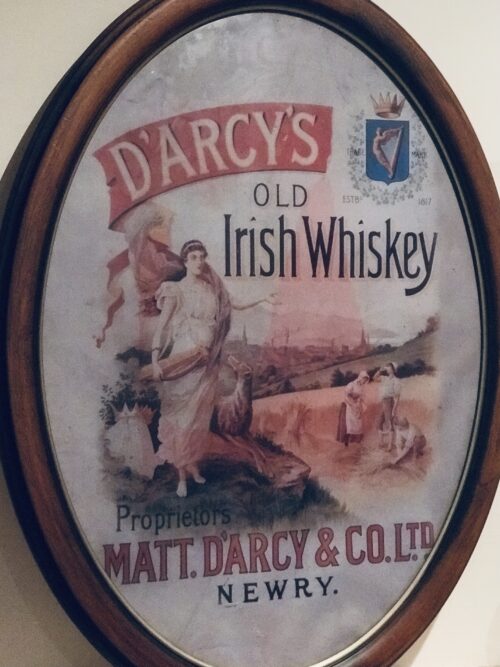























 Origins:Kilmaley Co Clare Dimensions : Glazed
Origins:Kilmaley Co Clare Dimensions : Glazed 


